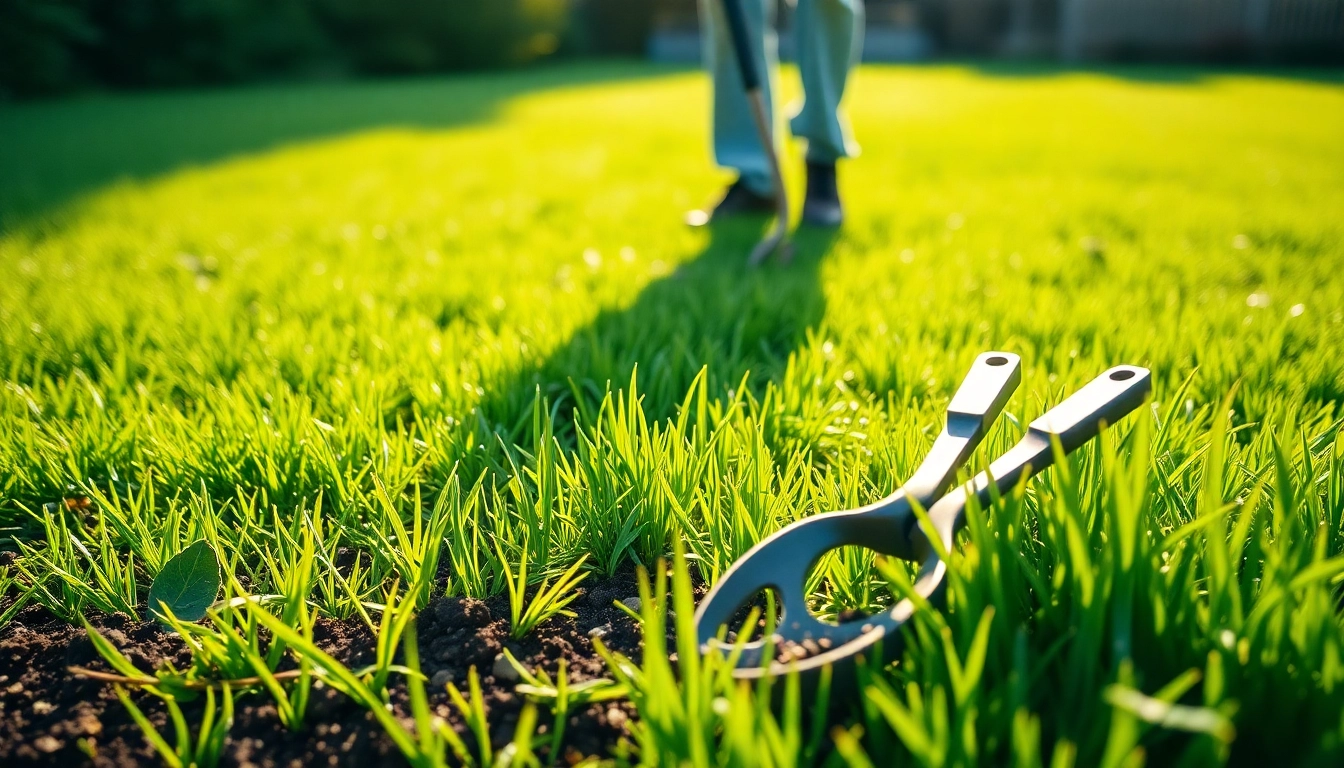Understanding Over Seeding
What is Over Seeding?
Over seeding is a lawn care practice that involves the process of spreading grass seed over an existing lawn. Unlike traditional seeding methods that require soil disruption or the creation of new planting areas, over seeding allows you to enhance your lawn without tearing up your existing grass or soil. This method is particularly beneficial for rejuvenating thin or patchy lawns, and it provides an opportunity to introduce new grass varieties that may be more resilient or better-suited to local climates.
This technique can significantly improve the appearance and health of your lawn. To achieve the best results, it is essential to understand the specific needs of your current grass and the type of seed you plan to introduce. For instance, using an over seeding strategy can mean the difference between a vibrant, lush lawn and one plagued by issues like weeds and thinning patches.
Benefits of Over Seeding
Over seeding comes with a myriad of benefits:
- Improves Lawn Density: By introducing new grass seed, over seeding effectively thickens your lawn. A denser lawn can help prevent weed growth by outcompeting them for resources like light and nutrients.
- Enhances Color: New grass varieties can introduce vibrant hues that contribute to a more appealing aesthetic for your outdoor space.
- Augments Soil Health: The process of over seeding can also improve soil health by adding nutrients when you mix different seeds and planting styles.
- Restores Damaged Areas: Bare patches and impaired sections of your lawn can be revitalized through the careful application of grass seeds in those areas.
- Increases Grass Resilience: By selecting drought-resistant or disease-resistant grass varieties, your lawn becomes stronger and better equipped to withstand environmental stressors.
Common Myths Debunked
While over seeding is celebrated for its benefits, several myths persist that may deter homeowners from utilizing this effective process:
- Myth 1: You Can’t Overseed a Thick Lawn: In reality, even thick lawns can benefit from over seeding to introduce new varieties and enhance resilience.
- Myth 2: Over Seeding is Only for Fall: While fall is ideal due to favorable conditions, over seeding can occur in spring as well, particularly for cool-season grasses.
- Myth 3: You Can Just Throw Seeds: While it’s tempting to simply scatter seeds, effective over seeding requires preparation of the lawn to ensure optimal seed-to-soil contact for germination.
When to Over Seed Your Lawn
Optimal Seasons for Over Seeding
Choosing the right time to over seed your lawn is critical to its success. The optimal seasons depend heavily on the type of grass you are working with:
- Cool-Season Grasses: The best time to over seed cool-season grasses like Kentucky bluegrass or ryegrass is during early spring or fall. Early spring offers the benefit of moist soil and mild temperatures, while fall conditions provide optimum growth conditions before the winter.
- Warm-Season Grasses: For warm-season grasses such as Bermuda or zoysia, late spring to early summer is the right time to over seed. The soil is warm, and sunlight availability is high, which maximizes growth potential.
Weather Conditions to Consider
Weather plays a crucial role in the success of over seeding. Several conditions to consider include:
- Temperature: Ideal soil temperatures for germination typically range from 65°F to 75°F for cool-season grasses and 70°F to 95°F for warm-season grasses.
- Moisture: Adequate moisture is vital. Regular rainfall or watering encourages seed germination and establishment. Particularly dry spells can hinder growth.
- Wind and Storms: High winds and storm conditions may wash away seeds or hinder their establishment; hence, aim for calm conditions when applying your over seeding treatment.
Signs Your Lawn Needs Over Seeding
It’s essential to recognize when your lawn may benefit from over seeding. Look for the following indications:
- Thinning Patches: Sections of your lawn are noticeably less dense or bare, exposing soil.
- Weed Invasions: If weeds are proliferating, it often indicates a weak or unhealthy lawn that could benefit from a boost.
- Seasonal Stress: Grass often suffers during extreme weather, leading to a decrease in vitality and density, highlighting the need for rejuvenation strategies.
How to Over Seed Effectively
Tools and Materials You Will Need
When preparing to over seed your lawn, gather the following tools and materials:
- Grass Seed: Select high-quality grass seed that is compatible with your existing lawn.
- Seed Spreader: A broadcast or drop spreader ensures an even distribution of seeds.
- Lawn Rake: Essential for loosening soil and removing debris.
- Fertilizer: A starter fertilizer can enhance seedling growth.
- Watering Equipment: A quality sprinkler or hose to keep the lawn adequately hydrated post-over seeding.
Step-by-Step Over Seeding Process
Follow these steps for a successful over seeding project:
- Mow Your Lawn: Cut your existing grass shorter than usual, about 1-2 inches, to allow better seed contact with the soil.
- Rake the Lawn: Use a rake to aerate the soil lightly and remove any dead grass or debris that could inhibit seed growth.
- Spread the Seed: Using a seed spreader, evenly distribute the chosen grass seed across the lawn. Aim to apply at the recommended rate specified on the seed packaging.
- Fertilize: Following the seeding, apply a starter fertilizer to provide essential nutrients for seedling growth.
- Water Thoroughly: Immediately water the area gently to ensure seed-to-soil contact and prevent runoff.
- Maintain Moisture: Keep the soil moist (not saturated) as seeds germinate and establish, typically for about two weeks.
Post-Over Seeding Care Tips
After over seeding, continued care is vital for optimal results:
- Avoid Heavy Foot Traffic: Reduce walking on newly seeded areas to prevent soil compaction and disturbance of seeds.
- Monitor for Weeds: Keep an eye on weed growth, especially in the early stages after over seeding, and address any issues promptly.
- Adjust Mowing Height: As new grass grows, allow for longer mowing heights to foster stronger root development.
Over Seeding Techniques for Various Grass Types
Choosing the Right Grass Seed
Selecting the appropriate grass seed is fundamental for successful over seeding. Some factors to consider include:
- Local Climate: Understand the growing conditions in your area—temperature, rainfall, and humidity levels—to choose grass varieties that will thrive.
- Sun vs. Shade: Identify areas of your lawn that receive varying sunlight, as shade-tolerant varieties are critical for areas with limited sun exposure.
- Type of Existing Grass: For effective blending, select grass seeds that are compatible with the existing species in your lawn.
Tailoring Techniques for Cool-Season Grasses
Cool-season grasses tend to thrive in regions with cold winters and moderate summers. Some tailored techniques include:
- Timing for Spring and Fall: As previously mentioned, the ideal seasons for over seeding these grasses are early spring or early fall, taking advantage of ideal germination conditions.
- Higher Seeding Rate: It may be beneficial to increase the seeding rate slightly to ensure a fuller lawn.
Strategies for Warm-Season Grasses
Warm-season grasses flourish in warmer climates. Implementing the following strategies can be beneficial:
- Late Spring Seeding: Conduct over seeding in late spring to early summer when soil temperatures promote quick germination.
- Use of Light Fertilization: After application, use fertilizers that are high in nitrogen to support growth in these sun-loving grasses.
Measuring Success After Over Seeding
Evaluating Lawn Health Post-Over Seeding
Determining the effectiveness of your over seeding efforts requires observation and analysis:
- Grass Density: Check for improved cover by observing the grass density in previously sparse areas.
- Color and Vigor: A healthy lawn should display rich color and vigorous growth; assess any lingering weak spots.
Long-term Maintenance Strategies
Continuous care is pivotal for maintaining a lush, healthy lawn post-over seeding:
- Regular Mowing: Maintain an appropriate mowing schedule to promote health while avoiding scalping (cutting too low).
- Periodic Fertilization: Implement a fertilization schedule that addresses the nutritional needs of your lawn.
- Consistent Watering Regime: Adapt your watering based on weather conditions to ensure optimal moisture levels.
Tracking Growth and Addressing Issues
Finally, it is essential to keep a close eye on your lawn following over seeding. Key indicators to monitor include:
- Frequency of Weeds: Track any resurgence of weeds and implement control strategies as necessary.
- Grass Growth Rate: Regularly evaluate how quickly the grass is growing in various areas, and make adjustments to care as needed.
- Soil Quality: Address soil health by periodically testing its nutrient levels and amending it accordingly.



